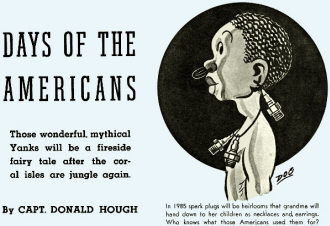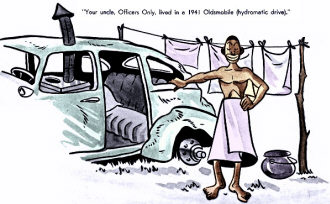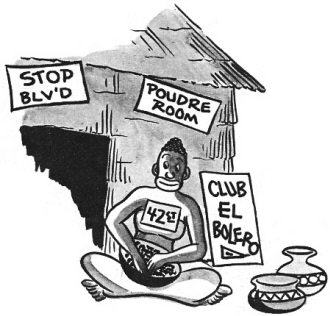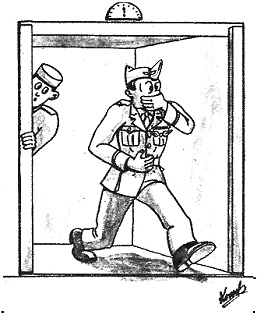|
"Days of the Americans"
is one chapter out of a book entitled "The Big Distance," by Capts. Elliott Arnold
and Donald Hough. Copies of it appear occasionally on eBay. Per this article which
appeared in the December 1945 issue of Flying Age magazine, "The Big
Distance, the official story prepared by the AAF, is to the struggle in the
Pacific what Germany was to the European phase of the war." Unlike the European
Theater of World War II, much of the populations of South Pacific islands were
inhabited by people who were barely out of the Stone Age in terms of cultural and
scientific evolution. The arrival of Northern hemisphere Western and European Anglo
Saxons brought a culture of sophistication never dreamed of by the backwards civilizations
indigenous to the islands. That was a common theme of the villages visited by the
McHale's Navy crew in the
1960s TV series. While reading the story, I was a bit taken aback by the narrative
of Americans having come to the island paradises and bringing their gigantic machines
and inexplicable habits, but then the author states, "There always will be a faction
among the elders who will attempt to establish the basic facts of the legend of
the Americans through use of pure logic, simply pointing out that if the Americans
had not been there, the Japs still would be. If the Americans weren't actually present,
the question will be posed to the more cynical of the youngsters, then what on earth
ever became of the Japs?" The Japanese of the day were utterly brutal and merciless
to foreigners whose lands they inhabited. Ask the elders of Shanghai, who still
have monuments to American
airmen who helped beat back the bloody Nipponese invasion.
Days of the Americans

In 1985 spark plugs will be heirlooms that grandma will hand
down to her children as necklaces and earrings. Who knows what those Americans used
them for?
Those wonderful, mythical Yanks will be a fireside fairy tale after the coral
isles are jungle again.
By Capt.·Donald Hough
Days of the Americans is one chapter in The Big Distance by Capts. Elliott Arnold and Donald Hough (Duell,
Sloan and Pearce, $3.00.) The Big Distance, the official story prepared by the AAF,
is to the struggle in the Pacific what Germany was to the European phase of the
war.
Some day the Americans - with their flying machines and their incredible monsters
of land and sea; with their moving pictures, their shower baths, their ridiculous
sense of humor; with all the things they did, and all the things they had that made
no sense - will be gone from the islands of the Southwest Pacific.
Nobody knows just when they will be gone, but the islanders have been there a
long time and have seen quite a few things of one sort and another and they know
that whatever all this fuss is about, in time they will go away as suddenly as they
appeared. Just where they will go is a matter of scarcely more than academic interest,
but in the past funny people have appeared and disappeared, loud noises have gone
on a while and then stopped, and only the islands and the jungles and the people
who belong in them have emerged.

"Your uncle, Officers Only, lived in a 1941 Oldsmobile (hydromatic
drive)."
The islanders know, of course, that they are living in a time of history; that
is to say, in a time of the birth of a legend, a form of historical record used
by primitive people to brush aside the pedantic nonsense of formal history and get
at its substance and its soul.
The islanders realize; I think we surely can assume, that this essence: of a
vast legend to come, a dilly of a legend, a legend to end all legends, now exists
in the living flesh, right before their eyes. The only thing they are afraid of,
perhaps, is that the thing is too hot for them to handle. There have been legends
of the past, of course, which to the untrained ear were right on the edge of being
unbelievable, even up to the point of being politely laughed at.
How to get by with this new one, this super one?
Here, if ever, are things to be called lies, come a couple of generations.
"The Days of the Americans," the legend will be called. Still, this is an awful
lot to try to get into a single legend, no matter how big it is. It may be better
to break the whole thing down into a series of smaller legends, easier to handle.
It may be better, the native grandfathers of 1985 may decide, to start out with
a few modest sublegends, such as that of the flying machines (fantastic but still
believable enlargement of nature) and the trucks (carabao inside instead of outside
the vehicle), then work up to the stiffer subjects, such as the motion pictures
(sheer legend) and the glass bottles (incredible legend made more incredible by
presence of existing evidence).
After such as these; then, the post-graduate legend: the Americans themselves.
Of course it goes without saying that the temptation to duck the whole subject
will be great. There are bound to be, among the legend-spinners of the days to come,
a certain percentage of barracks-room lawyers and general wise guys with a few words
of English who will point out that to bring up the subject at all in the presence
of the kids is to stick one's neck out a million leagues. They will counsel a dead-pan
approach:
"Okay, there weren't any Americans, the whole thing was just a big wind." Then
there will be the middle-of-the-roaders, the moderate Republicans, who will simply
tell the kids how it was when the Americans were around, and let it go at that,
take it or leave it.
Perhaps the majority of the elders will take the line that is traditional in
telling legends: just point to things, and to circumstances, and invite the listener
to explain them, if they know so much, in terms other than those that constitute
the legend itself.
All right, the elders who pursue this course will say, if the Americans weren't
here with their big pushers and tremendous noises, how about the thousands of trees,
these giant trees of the rain forest, the jungle, heaped up all helter-skelter in
all directions? You still can see the trunks plainly if you pull away the vines.
And if it is claimed that this was only a cyclone, how come those long smooth strips
where the trees used to be, strips of cleared space a quarter of a mile wide and
more than a mile long, now badly grown in the way the jungle does things, but with
pieces of the old steel mats still intact? Rusted away, they are, and nearly gone,
perhaps, but the pattern of their presence is still clear to keen eyes.

"Their quaint signs like 'Stop Boulevard', 'Officers Only' and
'Powder Room' live on in us who took American names, evidenced in the case of your
grandfather, Latrine Closed.
And what were these places used for, if not for the flying machines? If you don't
believe us, kids, you better come up with something. You've already seen the rusted
remnants of what we declare to be those flying machines, some with the outline of
the wings still traceable on the coral: the big ones, as large as from here to there,
vast in the wingspread, like great grasshoppers that had no legs but had four eyes
and could wiggle their eyelashes with unbelievable speed. And the slim ones that
could go on up and up until they were out of sight and could fly even while lying
on their backs.
Another thing: where do you think these trails came from? It is most flattering
to us, those of us who are of the generation that saw these things as youngsters,
to have it said that we, a super-race in our day, wore down these trails through
the jungle with our own feet, but that's just a lot of balla-walla. They're badly
grown in now, of course, but you've seen the places where they still exist - broad
enough for a village to stand on (with a little crowding at the edges) and curved
to shed part of the water, sweeping through the jungles, two-way stop streets if
we ever saw any, going as far in a single direction as a man can travel in a week
(a day or two off for fishing on the way.) Well, here's the point; if the Americans
didn't build them, who did? Secondly. If the Americans built them what were they
for? What, if not for the use of the machinery, the wheeled machinery, you've heard
mentioned. Think fast, baby, and make it good.
Now then, you've made the journey out to Buka Point to see that shape on the
coral. What is it the shape of? Agreed, it is the shape of a canoe, maybe a little
broad across the beam, or it's the shape of a cigar. But if it was a cigar, only
the Americans could have smoked it, so if you take the stand that it was not a canoe,
but a cigar, you prove the existence of the Americans anyway. If you want to know
the truth, that was one of the smaller ships - hardly a ship at all, in the American
standard of living. Take it or leave it alone, that was hardly more than a tub.
They had them easily fifty times as large, such as the one that's on the beach (you
can laugh, but it's there) at Morotai. All right, now we're getting someplace: what
were these ships used for, if not to bring the Americans?
Think it over ....
If it was not the Americans who came in those countless thousands of ships, from
the little ones with ants in their pants all the time to the monsters that had some
dignity under their tails, who was it? It must have been somebody, some people,
who lived a great ways off, otherwise they would have used fewer and smaller ships
- a question of ordinary logistics in anybody's language. In the time of the Americans,
there was naturally a good deal of discussion among us as to where they had come
from. Many supposed, naturally, that they came from the Milky Way, but there always
was an active minority declaring that they came from this very planet on which we
ourselves live. In the end, this latter view held more water than the other. It
was decided simply that the Americans came from America. Anybody, by looking at
the map, can see that there are around 8,000 miles of ocean between us and San Francisco,
and it is estimated that these ships would be just the size ships we would have
to have if we were to attempt military operations against the Pacific coast. So
the whole thing is perfectly clear, if you'll look at it calmly. The question persists:
if it was not the Americans who came this eight thousand miles from America in these
ships, who was it?
Let's, take a look at the record, It is written along the beaches, in the jungle,
along the roads and the airstrips, even in the shallow water, on the trees, right
in the huts of your own families. Take first the big loud things they had, some
well preserved (as in the water) and some evidenced by no more than a handful of
red dust, an odd radio tube, a slice of Spam, and other imperishable bits and pieces.
Many of the better-preserved specimens, of course, were salvaged by our lads. Your
uncle, Officers Only, lived in a 1941 Oldsmobile (hydromatic drive) staff car for
several years, and of course you've heard the tragic story of Baga Waga, his jeep
and the cliff at the south end of Biak ... We pounded a number of these things apart
and got spring leaves for making knives, inner tubes for beach use, wheels for hanging
in trees to serve as drums for our communications system, spark plugs for adorning
our ears, and so on.

"It used to say 'Budweiser' on it. That came off but still your
grandma bows down to it every evening. She caught that idea from the Americans she
saw."
This stuff was left over from the Big Pusher and Noise Department of the Americans.
At one time there was a very strong contingent among us given over to the conviction
that it was the noise that did all the work. To the untrained ear, it certainly
sounded like it. The uproar and crash and wham was worse than a thousand Niagara
Falls (Niagara Falls is a place in America that makes a lot of noise). Thunder?
You only think you've heard thunder. The Americans could get it for you wholesale,
in the large economy size. Some of these things, the largest and loudest that made
the most dust and in time of rain could go through mud up to a normal man's belly
button, were, so incredible that at times even the Americans themselves didn't believe
them. While they were working okay, the Americans were happy, shouting at each other
to get the hell out of the way, sometimes engaging in a coup de main to see which
one should have the right of way, and so on, but sometimes these things, and all
the noise that they made would stop, and the Americans would stand around, bewildered,
scratching their heads just like anybody else, afraid they were going to be put
on KP.
The little things, the odds and ends, that the Americans left behind proved the
most interesting and useful. Their signs, Stop-Boulevard, Broadway, Sixth Ave.,
This Space for the Commanding Officer, Closed for Inventory, Closed, Club El Bolero,
Powder Room, Officers Only, and so on, have gone, of course, but they live on in
us who decided to take on American names - as evidenced in the cases of your uncle,
Officers Only, and your late grandfather, Latrine Closed. It ought to be clear that
we didn't just make these names up.
Even while they were still here they were tossing aside things that any sensible
person could see were the choicest of their possessions. Some of these were nationally
advertised products, some were items supposed to be just as good. They even threw
away razor blades. That was one for the book; they'll use a razor blade a few times,
throw it away, then take out an identical razor blade and start all over again,
The finest things of all were their various containers, which they used only once
- having brought them 10,000 miles - and to hell with the taxpayers. Take the tin
things, they were ugly outside, and beautiful and useful only when the inside was
exposed, which was precisely when the Americans threw them away. You can chew on
that one a while. And those glass things! Nobody knows where the Americans got them;
certainly they were not the sort of things that could be made. Some of our people
tried to alter the shapes of them, and it didn't work. We concluded that they must
have them wild where the Americans come from, much as we have shells. You have seen
the one on the pedestal in your grandmother's parlor. It's brown, and has a sleek
body and it's sure a mighty pretty thing to see. It used to say "Budweiser" on it
but that came off. Your grandmother bows down to it every evening. She caught that
idea from, the Americans. She saw three of the American soldiers, the GI kind that
we got along so famously with, pick up the bottle on the coral one day - it evidently
had washed ashore from the Navy - and set it up on a rock and go through just those
same genuflections your grandmother uses. She's never quite sure she has it right,
it is from memory of course, but she does her best, bless her heart.
And so the legend will go.
There always will be a faction among the elders who will attempt to establish
the basic facts of the legend of the Americans through use of pure logic, simply
pointing out that if the Americans had not been there, the Japs still would be.
If the Americans weren't actually present, the question will be posed to the more
cynical of the youngsters, then what on earth ever became of the Japs?
The Americans, it will be explained, beat the Japanese, of course, and shagged
them all the hell out of here. That was the main job of the Americans, the elders
will point out ...
Not everybody knows how it was done, but we do, because we had the time to watch
and the brains to understand.

This comic is not related to the article, but appeared on a page
within the article. What's the gag line (pun intended†) here?
The Japs, or Nips, as we called them (American vernacular) would come in from
the sea in their frail boats and apologize to the jungle, sucking in their breath,
and get some little shovels and bamboo rakes and tin trowels and fix up a grade
D strip for their flying machines.
This strip would be muddy half the time and bumpy half the time; and they would
wiggle their carts and pale tin lizzies through the jungle over little, single wheel-track
trails, and it would take them forever to get any place or do anything; and after
they had been around for as long as two years there would be no change. They lived
like rats burrowing and scampering around on the theory that they were suffering
for the Emperor; and they'd get sick from malaria and the other things we have to
offer around here, and their people would just let them die, the sooner the better.
The Nips were funny people, They had started to imitate the Americans a long
time ago, you see, and they had the same kind of boats, on a modest scale, and the
same kind of weapons, on a lean budget, and their flying machines, though not as
large as those of the Americans were, nevertheless, swift as the very devil. But
this was all on the surface, and the war was won on a basis that was more than skin
deep. They just couldn't do anything with the Americans once the ice was broken.
They fancied themselves as jungle fighters and because they had this and the war
machinery, too, they couldn't figure to lose.
Now look at the Americans. They would come up to the jungle and throw the book
at it, which is exactly the way the jungle likes to be treated and will react to.
Then the Americans would base their flying machines there, and go out clear to hell-and-gone,
wherever the Nips were, and drop heavier stuff on them than the Nips ever had seen,
then they'd swoop down on them, go through like a hurricane on wheels, shooting
the guts out of them, and then the soldiers would come along and shoot some more
guts out of them, and the Nips would go to pieces. They just didn't know what to
do against all that firepower.
That brings us to a fundamental difference between the two people, the Nips and
the Americans. All their lives the Nips went in for making tiny fragile things by
hand and it was their nature. That is why their flying machines, a contraption of
very delicate balance, made up of a great many parts finely and intricately fitted
together and therefore right up the Nip's alley, were so good. But aside from their
ships, in which department they had a head start because they were Islanders and
always had had to use the sea for getting around, they just couldn't get the bang
of the big stuff. They didn't know how to make massive, brutal, roaring, jungle-killing
machines and they didn't even know how to use them. Just no soap, as your grandmother
says.
Another thing the Nips had been brought up on was saving things. They never really
had enough of anything but kids, of which history has proved they had too many.
An artillery shell, once you take it apart as your poor grandfather, Latrine Closed,
tried to do, is a thing of beauty and intricate mechanism. It seemed a pity to the
Nips to fire the thing off. They couldn't get over that, and it helped mightily
to beat them. They saved their ammunition, they saved everything but their men.
Then the Americans would come in, throwing everything at the Japs and the Japs would
slip right back a few centuries and burrow into caves and whimper and cry and in
the end, kill themselves. Every battle, however fiercely it started out, ended in
just that way. The Nips couldn't stand up to all this extravagance.
It was much the same deal in the air. The Nips were good at flying, they liked
to flutter around in the air, and they were brave in a rather silly and wasteful
way, and they would have been wonderful any place but where the Americans were.
For one thing, the Americans in the end, after struggling along on a really pitiful
basis, had more flying machines than the Nips could visualize as being within the
bounds of possibility. They kept blinking their eyes; they thought they were seeing
at least triple. For another thing, the Americans threw in their flying machines
where they were needed. If it was necessary to toss every single machine from all
available places into a single action. in order to win, they did it - a thing the
Nips never would countenance.
In a general way, then, my grandson, here's the pay-off: the Nips were trying
to play the American game. Now, in America, at least, you don't play the other fellow's
game if you want to come up with sandals for the bambino, and all this mechanical
stuff was strictly the American game.
Of course the Americans had no business sense, being willing to part with articles
of great value in exchange for a lot of dime-store junk that we'd whip up. But they
were kind. They gave us small things we fancied, and took us for rides, You stand
by the side of a road and do this with your thumb. They tried to understand us and
to do what they could to make each one of us feel at home.
Well, that's not the whole story of the war, of course. But it's enough for this
evening, and it's enough to give all of us something to remember next time we come
up against the Hill People: never play with the other fellow's dice and expect to
come up with a string of naturals.
† Note the pilots' wings on the guy. He can fly a plane but can't
handle an elevator ride?
Posted May 27, 2023
|